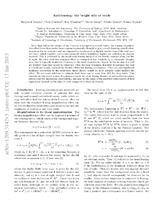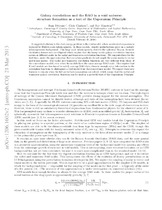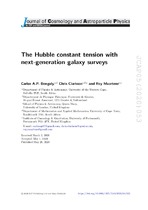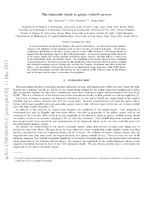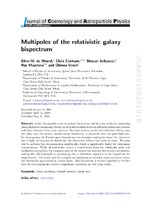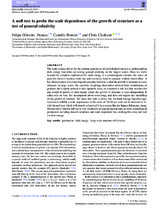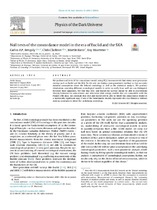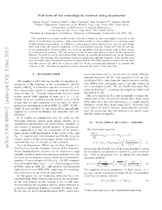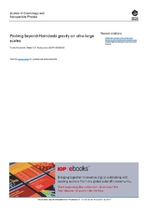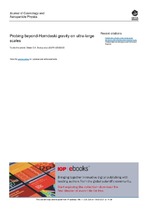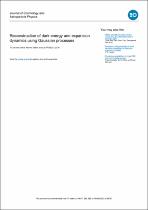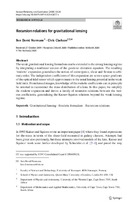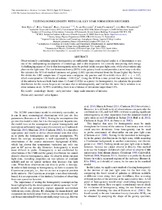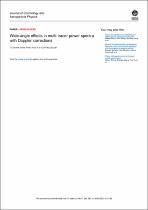Browsing Research Articles (Physics) by Author "Clarkson, Chris"
Now showing items 1-14 of 14
-
Anti-lensing: the bright side of voids
Bolejko, Krzysztof; Clarkson, Chris; Maartens, Roy; Bacon, David; Meures, Nikolai; Beynon, Emma (American Physical Society, 2013)More than half of the volume of our Universe is occupied by cosmic voids. The lensing magni ca- tion e ect from those under-dense regions is generally thought to give a small dimming contribution: objects on the far side ... -
Galaxy correlations and the BAO in a void universe: structure formation as a test of the Copernican Principle
February, Sean; Clarkson, Chris; Maartens, Roy (IOP Science, 2013)A suggested solution to the dark energy problem is the void model, where accelerated expansion is replaced by Hubble-scale inhomogeneity. In these models, density perturbations grow on a radially inhomogeneous background. ... -
The Hubble constant tension with next-generation galaxy surveys
Bengaly, Carlos A.P.; Clarkson, Chris; Maartens, Roy (IOP Publishing Ltd, 2020)The rate at which the universe is expanding today is a fundamental parameter in cosmology which governs our understanding of structure formation and dark energy. However, current measurements of the Hubble constant, H0, ... -
The kinematic dipole in galaxy redshift surveys
Maartens, Roy; Clarkson, Chris; Chen, Song (IOP Publishing, 2018)In the concordance model of the Universe, the matter distribution { as observed in galaxy number counts or the intensity of line emission (such as the 21cm line of neutral hydrogen) - should have a kinematic dipole due ... -
Multipoles of the relativistic galaxy bispectrum
Clarkson, Chris; de Weerd, Eline M.; Jolicoeur, Sheean (IOP Publishing Ltd, 2020)Above the equality scale the galaxy bispectrum will be a key probe for measuring primordial non-Gaussianity which can help differentiate between different inflationary models and other theories of the early universe. On ... -
A null test to probe the scale dependence of the growth of structure as a test of general relativity
Clarkson, Chris; Franco, Felipe Oliveira; Bonvin, Camille (Oxford University Press, 2019)The main science driver for the coming generation of cosmological surveys is understanding dark energy that relies on testing general relativity on the largest scales. Once we move beyond the simplest explanation for dark ... -
Null tests of the concordance model in the era of Euclid and the SKA
Bengaly, Carlos; Clarkson, Chris; Kunz, Martin; Maartens, Roy (Elsevier, 2021)We perform null tests of the concordance model, using H (z) measurements that mimic next-generation surveys such as Euclid and the SKA. To this end, we deploy a non-parametric method, so that we make minimal assumptions ... -
Null tests of the cosmological constant using supernovae
Yahya, Sahba; Seikel, Marina; Clarkson, Chris; Maartens, Roy; Smith, Mathew (American Physical Society, 2014)The standard concordance model of the Universe is based on the cosmological constant as the driver of accelerating expansion. This concordance model is being subjected to a growing range of inter-locking observations. ... -
Probing beyond-Horndeski gravity on ultra-large scales
Moloi, Teboho; Duniya, Didam; Clarkson, Chris (2020)The beyond-Horndeski gravity has recently been reformulated in the dark energy paradigm — which has been dubbed, Unified Dark Energy (UDE). The evolution equations for the given UDE appear to correspond to a non-conservative ... -
Probing beyond-Horndeski gravity on ultra-large scales
Duniya, Didam G.A.; Moloi, Teboho; Clarkson, Chris (IOP Publishing Ltd, 2020)The beyond-Horndeski gravity has recently been reformulated in the dark energy paradigm — which has been dubbed, Unified Dark Energy (UDE). The evolution equations for the given UDE appear to correspond to a non-conservative ... -
Reconstruction of dark energy and expansion dynamics using Gaussian processes
Seikel, Marina; Clarkson, Chris (IOP Publishing, 2012)An important issue in cosmology is reconstructing the effective dark energy equation of state directly from observations. With few physically motivated models, future dark energy studies cannot only be based on constraining ... -
Recursion relations for gravitational lensing
Clarkson, Chris; Normann, Ben David (Springer Nature, 2019)The weak gravitational lensing formalism can be extended to the strong lensing regime by integrating a nonlinear version of the geodesic deviation equation. The resulting ‘roulette’ expansion generalises the notion of ... -
Testing homegeneity with Galaxy Star formation histories
Hoyle, Ben; Jimenez, Raul; Maartens, Roy; Heavens, Alan; Clarkson, Chris; Tojeiro, Rita (IOP Publishing, 2013)Observationally confirming spatial homogeneity on sufficiently large cosmological scales is of importance to test one of the underpinning assumptions of cosmology, and is also imperative for correctly interpreting dark ... -
Wide-angle effects in multi-tracer power spectra with Doppler corrections
Paul, Pritha; Clarkson, Chris; Maartens, Roy (IOP Publishing, 2023). We examine the computation of wide-angle corrections to the galaxy power spectrum including redshift-space distortions and relativistic Doppler corrections, and also including multiple tracers with differing clustering, ...

